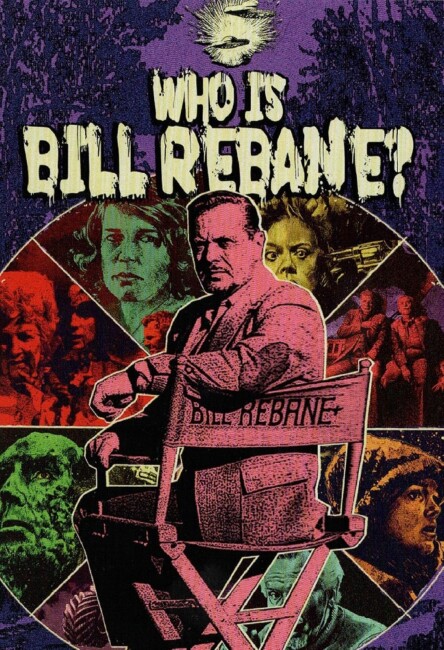USA. 2021.
Crew
Director/Screenplay – David Cairns, Producer – Neil Snowdon. Production Company – Arrow Video.
With
Sarah Auerswald, Stephen R. Bissette, Mark Borchardt, Peter Clemence, Randall William Cook, Mark Cousins, David Doyle, Matt Farley, Jim Healy, Jim Iaquinta, Brian Jennings, Randy Jurgensen, Jim Knipfel, Steven Poster, Bill Rebane, Ben Reiser, Andy Romanoff, Charlie Roxburgh, Cory Udler, Jim Zabilla
Bill Rebane is a director whose name few people have heard of or know. Rebane has however made a reasonable body of low-budget films that include the likes of Monster-a-Go-Go (1965), Invasion from Inner Earth (1974), the legendary The Giant Spider Invasion (1975), Rana: The Legend of Shadow Lake (1975), The Alpha Incident (1978), The Capture of Bigfoot (1979), The Game (1982), The Demons of Ludlow (1983), Blood Harvest (1987) and Twister’s Revenge! (1988).
I only had a passing familiarity with Rebane’s and had seen a couple of his films before watching Who is Bill Rebane?, a Documentary about his films and career. Afterwards, I knew far more about him than I probably ever wanted to and was certainly left intrigued enough to want to go and track down more of his films. The opening intro where people talk of Rebane in terms of someone “crazy as a bedbug” and only rumoured to have a studio in the hinterlands of Wisconsin, certainly gets your attention from the outset.
Who is Bill Rebane?covers Rebane’s life and career in exhaustive detail – from his childhood growing up in Latvia during World War II, with his family as refugees having to hide in bunkers from the war around them, before emigrating to the USA. The various interviewees even spend some time discussing the weirdness of Rebane’s adopted home state Wisconsin and how it affects people’s minds. We get discussion of Rebane’s tentative filmmaking career, a short film about the twist, which was bought up by AIP and incorporated into their twist film The Continental Twist/Twist All Night (1961). Rebane tells how he was offered a directorial assignment by AIP head Samuel Z. Arkoff only to commit the cardinal sin of saying he didn’t like the script. He ruefully reflects on how different his career might have been if had taken the opportunity.
The documentary’s director David Cairns spends quite a bit of time analysing Rebane’ first full film Monster-a-G-Go. It was affected by a series of hilarious technical problems – where the cameras recording made audible noise or the sound equipment picked up radio signals meaning that radios are placed in some shots to disguise this; how the attempts to steal power from a building ended up blowing out the transformer at a radio station; how by the time of reshoots actors ended up leaving, meaning that characters just disappear from the story. We learn how Herschell Gordon Lewis stepped in to complete the film, adding extra material, so that it could be released on a double-bill with his film Moonshine Mountain (1964). Cairns goes to some length to analyse Monster-a-G-Go’s narrative shortcomings, strange characters gaps and lack of any real ending.

Cairns spends some time also discussing Invasion from Inner Earth, where he even goes so far as to defend the film’s lack of incident – it is an alien invasion film that takes place in a remote cabin – and speaks in favour of the authenticity of the stilted acting and Rebane’s fascination with UFO lore and the idea of having UFOs originating from a Hollow Earth. One of the interviewees Stephen R. Bissette even goes so far as to see the film’s ending as echoing 1970s Rapture films.
We next move to The Giant Spider Invasion, Rebane’s magnum opus, and assorted stories concerning the Volkswagen Spider (where the giant spider was a VW with a spider armature built over the top of it). The Capture of Bigfoot, Rana and Twister’s Revenge don’t get as much time and in-depth analysis. There is brief mention of Blood Harvest, Rebane’s film outing with Tiny Tim, and even of how much Rebane disliked renting out his ranch studio for Ulli Lommel to shoot The Devonsville Terror (1983) and his frustration at Lommel’s practice of shooting without a script. The sad bookend to Rebane’s career was how he ended up having a heart-attack during the 1990s and losing the ranch.
What becomes rather funny about Who is Bill Rebane? is the film school seriousness with which David Cairns analyses Rebane’s work. At one point, Cairns even compares Rebane to Hitchcock. There is analysis of the tensions between educated/uneducated, men/women in his films. Or discourses on the nature of Rebane’s ad hoc directorial style and lack of narrative, leaving key plot elements to take place off-screen, even analysis of his shot choices and style/lack of style. Sample piece of voiceover narration: “The non-Cartesian logic of films like Halloween (1978) and The Shining (1980) allow Rebane to make a movie where a few slender threads of logic contrive to hold together a surreal bushel of murders, hauntings and decapitations.” It rather funnily gives far more weight to Rebane’s films than Rebane himself ever did and in truth more than most of them are worth.
Trailer here


